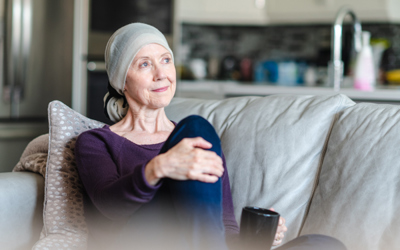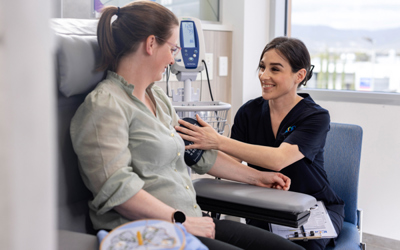What are the treatment options for acute lymphoblastic leukaemia?
The primary treatment options for acute lymphoblastic leukaemia (ALL) include chemotherapy and targeted therapies. The type of treatment you receive will depend on a number of different considerations, such as your overall health and your treatment preferences. This page aims to give you a comprehensive overview of how acute lymphoblastic leukaemia treatment works.
Chemotherapy for acute lymphoblastic leukaemia
Chemotherapy is the primary treatment for ALL. It uses a range of drugs to kill and slow the growth of acute lymphoblastic leukaemia cells.
Learn more about chemotherapy and how it is delivered.
When treating acute lymphoblastic leukaemia, chemotherapy is delivered in three different therapy phases known as induction, consolidation and maintenance.
Induction therapy – Usually delivered in a cycle of four to six weeks, induction therapy is an intense phase of treatment that aims to destroy as many abnormal white blood cells as possible. You will usually spend the duration of your induction treatment in the hospital, as well as some time afterwards, as this initial phase of treatment is very intensive and may cause infections and complications if not monitored closely
Consolidation therapy – Consolidation therapy helps prevent the return of acute lymphoblastic leukaemia and uses a number of different drugs to destroy any remaining cancer cells. This phase takes place over a span of a few months
Maintenance therapy – While this final step of chemotherapy treatment is rarely needed, maintenance therapy may be used over a span of two to three years. Similar to consolidation therapy, the aim is to prevent the return of ALL cells and is a less intense form of treatment compared to induction and consolidation therapies
Common chemotherapy medicines
There are a number of different chemotherapy drugs that are used to treat acute lymphoblastic leukaemia. Depending on the type of acute lymphoblastic leukaemia that you have, you may receive a combination of chemotherapy drugs (protocol) delivered through injection or in pill form. Commonly used chemotherapy protocols include hyper-CVAD and CALBG.
Some of the drugs used include:
-
Vincristine
This drug works by interfering with the process of cell division, preventing them from being able to divide and grow. It is given by intravenous infusion, usually in combination with other chemotherapy drugs.
-
Doxorubicin
This chemotherapy drug destroys cancer cells or stops their growth by interfering with the way that DNA is made within cells. It is given by an intravenous infusion and is bright red in colour.
-
Cyclophosphamide
This treatment is in a class of chemotherapy drugs called alkylating agents. It works by damaging the DNA of cells so they are unable to divide, causing them to stop growing and die. It is given by intravenous infusion.
-
Daunorubicin
This is part of a group of chemotherapy drugs called anthracyclines which work by stopping cells from being able to make DNA, slowing or stopping the growth and spread of cancer cells. It is given by intravenous infusion.
-
Cytarabine
Cytarabine is in a class of chemotherapy drugs called antimetabolites. They work by interfering with the DNA production of cells, so they are unable to divide and grow. It is given by intrathecal injection into the space outside the spinal cord.
-
Asparaginase
This is an enzyme that helps to breakdown the amino acid asparagine in the body. This reduces the level of asparagine in the body which leukaemia cells need to survive. It can be given by subcutaneous injection under the skin or intravenous infusion.
-
Methotrexate
This is an antimetabolite chemotherapy drug that interferes with the ability of cancer cells to use folic acid for the production of DNA, which they need to survive. It is given by intravenous infusion and, in some cases, by intrathecal injection into the space outside the spinal cord.
-
Mesna
This is not a chemotherapy drug but is a chemoprotectant drug, which is used to help reduce the side effects of chemotherapy in the body. It is typically given by intravenous infusion over 24 hours.
Targeted therapies for acute lymphoblastic leukaemia
Targeted therapies use specialised drugs to destroy ALL cells by focusing on abnormalities found within cancer cells, while avoiding normal healthy cells. If the Philadelphia chromosome is present in your cancer cells, targeted therapies are usually used as the primary form of treatment. Targeted therapies may be delivered alone or in combination with other chemotherapy drugs.
Common targeted therapy medicines
Common targeted therapy drugs which are used to treat acute lymphoblastic leukaemia include:
-
Ponatinib
This drug is known as a tyrosine kinase inhibitor, which blocks the action of several different receptors which are present on the surface of leukaemia cells including VEGF (vascular endothelial growth factor) and TKI (tyrosine kinase). Blocking these receptors prevents the growth of blood vessels that supply nutrients to leukaemia cells, stopping them from being able to divide and grow. It is given orally as a tablet once daily.
-
Dasatinib
This is a multi-target tyrosine kinase inhibitor that works by targeting and blocking different tyrosine kinases, slowing and stopping leukaemia cell growth. It is given orally as a tablet once daily.
-
Blinatumomab
This is a monoclonal antibody that works by targeting specific proteins called CD19 which are present on the surface of ALL cells, allowing your own immune system to attack the cancer cells.
Bone marrow transplant for acute lymphoblastic leukaemia
Bone marrow transplants, which are also referred to as stem cell transplants, replace cancerous bone marrow with healthy stem cells that help stimulate the development of new, healthy bone marrow. In order to destroy leukaemia-producing bone marrow, you will first receive high doses of chemotherapy before the healthy stem cells are transplanted.
Not all people with acute lymphoblastic leukaemia will require a bone marrow transplant. The need for transplant depends on the risk of relapse which is assessed on an individual basis related your condition, genetic features of the leukaemia and its response to treatment.
Bone marrow transplants for acute lymphoblastic leukaemia are done with cells donated from another person, this is known as an allogenic transplant. The donor must be a match to donate but may be a relative or an unrelated donor found through an international search. A bone marrow transplant involves giving high doses of chemotherapy with or without radiotherapy followed by the infusion of donor stem cells into your bloodstream.
Clinical trials for acute lymphoblastic leukaemia
Icon offers a wide range of clinical trials providing patients with access to new and evolving treatments. Clinical trials offer hope and opportunity and contribute to breakthroughs in treatment for future cancer patients.

Treatment by stage of acute lymphoblastic leukaemia
As the traditional cancer staging system is not used to stage ALL, treatment for acute lymphoblastic leukaemia instead focuses on long-term chemotherapy, usually lasting about two years. Chemotherapy treatment will be delivered in a three-phase approach: induction, consolidation and maintenance. In consolidation and maintenance, targeted therapy drugs may also be used depending on if your acute lymphoblastic leukaemia cells have the Philadelphia chromosome.








